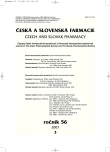Thermoplastic granulation as an alternative method for the preparation of hydrophiliclipophilic oral matrix tablets
Authors:
K. Dvořáčková; M. Rabišková; R. Masteiková; L. Vocilková
Authors‘ workplace:
Veterinární a farmaceutická univerzita v Brně, Farmaceutická fakulta, Ústav technologie léků
Published in:
Čes. slov. Farm., 2007; 56, 129-134
Category:
Original Articles
Overview
The paper focuses on the formulation of HPMC K-matrix tablets by compression of granulates previously prepared by melt granulation. The model drug was theophylline monohydrate. Montanglycol wax was used as the solid lipid binder in a concentration of 10-20 %. With respect to the obtained results, thermoplastic granulation was found to ensure suitable porosity, flow, and particle size of the granulates. In both dissolution media (phosphate buffer pH 6.8 and artificial gastric juice pH 1.2), the release of the model drug is dependent on the HPMC viscosity grade used. The release rate can be modified by a change in the HPMC-to-montanglycol wax ratio. A decrease in this ratio increases the liberation of theophylline monohydrate. Due to different drug solubilities in the selected dissolution media, theophylline is released significantly faster in phosphate buffer pH 6.8 then in artificial gastric juice pH 1.2. The matrices of the same composition were prepared by direct compression; the comparison of dissolution profiles shows that the release of the active substance is not influenced by the employed method of manufacture.
Key words:
matrix tablets – melt granulation – HPMC – wax – controlled release
Labels
Pharmacy Clinical pharmacologyArticle was published in
Czech and Slovak Pharmacy

2007 Issue 3
Most read in this issue
- Naphthoquinones and their pharmacological properties
- Thermoplastic granulation as an alternative method for the preparation of hydrophiliclipophilic oral matrix tablets
- Chitosan in topical preparations
- Medicinal preparations in a manuscript of a fifteen-century Franciscan monk in Brno
